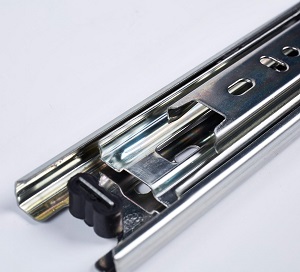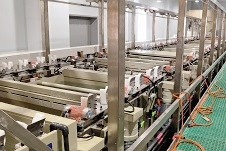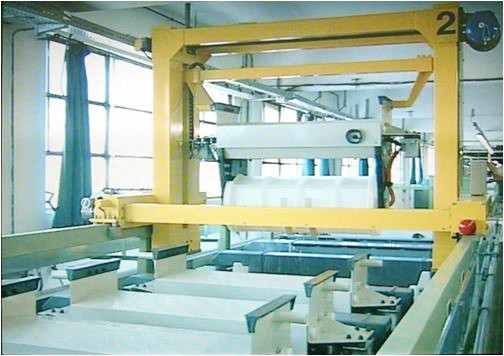1. Pinhole
The pinhole is due to hydrogen adsorbed on the surface of the plated part and delayed release.The plating solution cannot moisten the surface of the plated part, so that the plating layer cannot be electrodeposited.With the increase of coating thickness around the hydrogen evolution point, a pinhole is formed at the hydrogen evolution point.It is characterized by a shiny round hole and sometimes an upward small tail.When there is no wetting agent in the plating solution and the current density is high, pinholes are easy to form.
2. Pockmarks
Pitting is due to the unclean plating surface, adsorption of solid substances, or suspension of solid substances in the plating solution. When they reach the workpiece surface under the action of electric field, they are adsorbed on it, which affects the electrodeposition. These solid substances are embedded in the electroplating layer to form small bumps (pitting).It is characterized by convexity, no brightness and no fixed shape.In short, it is caused by dirty workpiece and dirty plating solution.
3. Airflow stripes
The gas flow stripe reduces the cathode current efficiency due to excessive additives, too high cathode current density or too high complexing agent, resulting in a large amount of hydrogen evolution.If the bath flows slowly and the cathode moves slowly at that time, the arrangement of electrodeposition crystals is affected in the process of hydrogen rising against the workpiece surface, forming gas flow stripes from bottom to top.
4. Mask (exposed)
The masking is because the soft overflow at the pin on the workpiece surface has not been removed, so the electrodeposition coating cannot be carried out here.The substrate can be seen after electroplating, so it is called exposed (because the soft overflow is translucent or transparent resin).
5. The tin coating is brittle.
After SMD plating and rib cutting, it can be seen that there is cracking at the bend of the pin.When the nickel layer cracks between the nickel layer and the substrate, it is determined that the nickel layer is brittle.When there is a crack between the tin layer and the nickel layer, it is determined that the tin layer is brittle.Brittleness is mostly caused by excessive additives and brighteners, or too many inorganic and organic impurities in the plating solution.
6. Air bag
The formation of air bag is due to the shape of workpiece and gas accumulation conditions.Hydrogen accumulates in the “bag” and cannot be discharged to the liquid level of the plating solution.The presence of hydrogen prevents electrodeposition of the coating.Make the part where hydrogen accumulates free of coating.When electroplating, as long as pay attention to the hook direction of the workpiece, the air bag phenomenon can be avoided.As shown in the figure, when the workpiece is electroplated, when it is hooked perpendicular to the bottom of the plating bath, no air bag will be generated.When hooked parallel to the groove bottom, it is easy to produce gas bags.
7. A “tin flower” is opened in the center of the plastic sealed blackbody.
There is a tin coating on the blackbody. This is because the upward parabola of the gold wire is too high when the electron tube is in the welding line. During plastic packaging, the gold wire is exposed on the blackbody surface, and the tin is plated on the gold wire, like a flower.It’s not a plating solution problem.
8. “Climb tin”
There is a tin layer at the junction (root) of the lead and the blackbody, climbing up the blackbody like a wall climbing grass. The tin layer is a dendritic loose coating.This is because in the pre plating treatment, the SMD frame is brushed with a copper brush, and the worn copper powder embedded in the blackbody is not easy to wash off and becomes a conductive “bridge”. During electroplating, as long as the electrodeposited metal builds a “bridge”, it extends, the dendritic deposition climbs to connect with other copper powders, and the tin climbing area is becoming larger and larger.
9.”Whisker tin” is at the junction of the lead and the blackbody, there is whisker like tin on both sides of the lead, and there is tin coke like tin pile at the junction of the front face of the lead and the blackbody.
This is because when SMD frame is plated with silver by masking method, the masking device is not tight, and silver is also plated where silver plating is not required.During plastic packaging, some silver layers are exposed outside the blackbody.During the pretreatment, the silver layer is pried up, and the tin plated on the silver is like whiskers or piles of tin.Overcoming the exposure of silver layer is one of the keys of silver mask plating technology.
10. Orange peel coating
When the substrate is very rough, or there is corrosion during the pretreatment, or when the ni42fe + Cu substrate is treated before plating, some copper layers have been removed, while the copper layers in some areas have not been removed, and the whole surface is not smooth.The above conditions may cause the orange peel state of the coating.
11. Cavity plating
There are irregular pits (different from pinholes) on the surface of the coating, which is a “ceiling face” coating.There are two situations that may form a “ceiling face” coating.
(1) Some units use glass bead spraying method to remove spills.When the air pressure is too high, the kinetic inertia of the glass beads will impact the plated surface into small pits.When the coating is thin and the pit is not filled, it becomes a “ceiling face” coating.
(2) The metallography of the base material alloy is uneven, and there is selective corrosion in the process of pretreatment before plating.(the more active metal is etched first to form a cavity). After electroplating, if the concave hole is not filled, it becomes a “ceiling face” coating.
For example, for ni42fe base material, if Ni and Fe are not fully mixed evenly in the metallurgical process, there may be uneven alloy metallography in some areas on the material surface after rolling.During pre plating treatment, because Fe is more active than Ni, selective etching is preferred to form pits.If the electroplated coating cannot level the pit, it becomes a “ceiling face” coating.Similarly, zinc brass also has such a phenomenon. If the copper zinc metallography is uneven, zinc is selectively corroded first than copper during pre plating treatment, so that the substrate is concave, and the concave coating is formed after electroplating.
12. Loose dendritic coating
When the plating solution is dirty, the concentration of main metal ions is high, the complexing agent is low, the additives are low, the anode and cathode are too close, the current density is too high, and it is easy to form loose dendritic coating in the current area.The loose coating is like foam plastics, and the branches are uneven.
13. Double coating
The formation of double-layer coating mostly occurs when the operating temperature of the plating solution is relatively high. In the electroplating process, the workpiece is put out of the plating tank and hung into the continuous plating again.In this process, if the workpiece is raised for a long time, the plating solution on the workpiece surface precipitates salt frost due to water evaporation and is attached to the workpiece. When the salt frost is not dissolved in time, the coating is plated on the salt frost surface to form a double-layer coating, like Huafu biscuit. A layer of salt frost is sandwiched between the two coatings.
To avoid double-layer coating, the workpiece can be shaken in the plating solution for a few seconds before continuous plating, and then electrified for continuous plating after the salt frost is dissolved.
14. The coating is blackened.
The main reason for the blackening of the coating is the high metal and organic impurities in the plating solution, especially in the low current density area;In the case of insufficient additives, black coating will also appear in the middle of large plated area;If the temperature is too low and the ion activity is small, a gray black coating will be formed when the current is too high.For the treatment of metal impurities, corrugated plate can be used as cathode for electrolysis at 01-0.2a/dm2.Organic pollution can be treated with 3-5g / L activated carbon.Use granular and wash with pure water first.
15. Blunt peeling.
Ni42fe alloy is easy to blunt. Activation before plating includes two chemical processes, one is oxidation process and the other is oxide dissolution process.If the oxidation process is not sufficient or the oxide is not dissolved in time, there is still oxide residue on the plated surface, and the coating will be peeling or rough.
16. Replacement peeling
If there are two different materials on the same workpiece.For example, the surface of copper substrate is nickel plated, and copper is exposed on the notch after cutting and forming.When the copper ion in the strong etching groove increases to a limit value, the replacement copper layer is easy to be generated on the nickel layer.With replacement copper, the tin layer will peel off after tin plating.In this case, only the strong corrosion solution can be updated frequently to avoid replacement peeling.
17. Oil pollution peeling
If the oil is not removed in the pre plating treatment, there will be no coating in the oil polluted area during electroplating. Even if the coating is covered, it is false plating. The coating has no binding force with the substrate, which bulges one by one like rubella, and falls off when wiped.
18. Dark round spot coating
When the workpiece has a large plated area, such as the heat sink of the pipe.When there are many impurities in the plating solution or insufficient additives, a gray black dark round spot coating will be formed in the center of the heat sink, like a plaster.Because the center of a large area is a low current region, impurities are concentrated here.Or when the additive is insufficient, the depth ability of the plating solution decreases.
19. The coating has uneven gloss and obvious (visual) uneven thickness.
This is because the additives have just been added, and the additives are not fully dispersed, resulting in inconsistent bath characteristics.After the additives are evenly dispersed, the fault will disappear naturally.
20. The plating solution is polluted by chemical fibers, and it can be seen that the coating is embedded with a trace of chemical fibers.
This fault can be overcome by making PP cloth of anode bag with soldering iron ironing method.
21. Mold pollution in the plating solution
It is more common in nickel plating bath because PH4-5 environment is suitable for mold growth.
It can be seen that mold bacteria are embedded in the electroplated layer.In this case, disinfection and sterilization measures should be taken. In order to avoid mold pollution, we must pay attention to the implementation of cylinder opening procedure of production line.
22. Moss pollutes water quality.
The workpiece is rinsed in water containing bryophytes, which adhere to the workpiece and firmly adhere to the workpiece after drying, affecting the product quality.Every spring, we should pay attention to the possibility of moss pollution and establish a sense of prevention.If the moss contaminates the bath, the moss will be embedded in the coating.
23. The porosity of the coating is high.
The high porosity of the coating affects the appearance of the coating, the protective characteristics of the coating, shortens the storage period, affects the weldability, and the brittleness of the coating is large.Most of the reasons are dirty plating solution, more metal impurities and more organic impurities.The method to identify the porosity of coating is to directly identify the characteristics of plating solution.Hang the polished degreased stainless steel sheet into the electroplating for about 0.5-1h. If the coating completely encapsulates the stainless steel sheet, and the coating can be scraped with a knife from the edge, the whole coating can be torn off with good toughness to form a whole coated sheet.Aim the coated sheet squarely at the sunlight. If the pores are not visible, it proves that the characteristics of the plating solution are good. If the transparent electricity (pores) are visible, it proves that the characteristics of the plating solution are poor;If the coating cannot be removed from the stainless steel sheet and the coating tilts up like a fish scale, it proves that the characteristics of the plating solution are very poor and the plating solution needs large treatment.
24. There are regular differences in coating thickness on the same hanger.
This is due to the inaccurate projection of anode and cathode graphics (the relative position of anode and cathode is not suitable) and the uneven distribution of power lines.There are regular differences in plating thickness on the same hanger.This is because the hook elastic contact resistance of each workpiece is different.The coating with good contact is thick, otherwise it is.It's the quality of the pylon.If there are two hangers in the same slot, one of them has a thick coating and the other is thin, this is because the aging degree of the two hangers is different, the contact resistance of the newer hanger is small and the coating is thick, otherwise.If the projection of anode and cathode is correct, the aging degree of the two hangers is the same, but the coating thickness is thick on one side and thin on the other side, which changes regularly.This is due to corrosion or salt frost on the cathode on one side, resulting in poor electrical contact.In order to conduct electricity well on both sides of the plating bath and eliminate the defect of large voltage drop when one side is powered on, if the length of the plating bath is greater than 1m, both ends need to be powered on, and it should be cleaned regularly to maintain good electrical contact.
25. Some workpieces have black spots on the surface.There may be two reasons for this:
(1)The hanger envelope is aged and cracked, and the acid-base salt exuded from the crack is sprayed by compressed gas and splashed on the workpiece, polluting the coating.
(2) The surface of rinsing water is too low to rinse the workpiece on the upper layer of the hanger.The workpieces and hanging teeth that cannot be rinsed cross contaminate each other when the medicine drops.Therefore, the rinsing liquid level must be higher than the workpiece on the uppermost layer of the hanger.
(3) Droplet cross contamination.
(4) There is oil in the gas.
(5) Manual unloading operation pollution.
26. There are two possible conditions for the workpiece to change color (turn yellow) after plating and drying or change color after a short storage time:
(1) The concentration of neutralization solution is too thin and the temperature is too low to remove the film.
(2) The crystal of the coating is rough, which increases the difficulty of rinsing and removing the film.
27. There are tin nodules on the coating surface.
This is because the anode mud pollutes the plating solution and the PP bag is broken. When the anode is dissolved, on the one hand, it is transferred into the plating solution in the form of ions, and some are rushed into the plating solution in the form of atoms and atomic groups to pollute the plating solution.When atomic clusters contact the workpiece, they are embedded in the coating to form tin nodules.
28. Blackbody heterochromaticity
That is, the black plastic body becomes gray black.This is because the frame stays in alkali solution for too long in electroplating pretreatment or neutralization tank, and the blackbody has been alkali corroded.The components of the blackbody include epoxy, leveling agent, curing agent, anti-aging agent, white filler, melanin and so on. When the blackbody is corroded by alkali, it will reveal the filler.White + black is a gray (heterochromatic) phenomenon.








 Nov. 01, 2021
Nov. 01, 2021 



